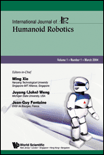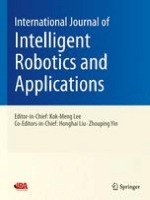
Frontiers in Robotics and AI
Scope & Guideline
Leading the Charge in Robotics and Artificial Intelligence Exploration
Introduction
Aims and Scopes
- Human-Robot Interaction (HRI):
Research exploring the dynamics of interactions between humans and robots, including social, emotional, and communicative aspects. This includes studies on trust, acceptance, and the role of robots in various social contexts. - Robotic Systems and Control:
Development and optimization of control algorithms for various robotic systems, including mobile robots, manipulators, and autonomous vehicles. This encompasses methodologies for both model-based and model-free approaches. - Soft Robotics and Bioinspired Design:
Investigation of soft robotic systems that mimic biological organisms, focusing on their design, actuation, and control. This area emphasizes the application of soft materials and bioinspired mechanisms for versatile robotic functionality. - Assistive and Rehabilitation Robotics:
Research dedicated to the development of robotic systems aimed at aiding individuals with disabilities or rehabilitation needs. This includes exoskeletons, socially assistive robots, and technologies for enhancing mobility and daily living. - AI and Machine Learning in Robotics:
Integration of artificial intelligence and machine learning techniques into robotic systems to enhance perception, decision-making, and autonomy. This encompasses deep learning, reinforcement learning, and cognitive robotics. - Robotics in Healthcare:
Application of robotic technologies in medical settings, including surgical robots, rehabilitation systems, and telemedicine. This area focuses on improving patient outcomes and enhancing healthcare delivery through robotic assistance. - Environmental and Agricultural Robotics:
Exploration of robotic systems designed for environmental monitoring, agriculture, and natural resource management. This includes autonomous systems for tasks such as crop monitoring, pest control, and sustainable farming practices.
Trending and Emerging
- Cognitive and Social Robotics:
An increasing focus on the cognitive capabilities of robots, including emotional intelligence and social interaction, reflects a trend towards developing robots that can understand and respond to human emotions and social cues. - AI-Driven Robotic Systems:
The integration of AI and machine learning techniques into robotics is a significant emerging trend, enhancing robots' ability to learn and adapt to their environments autonomously. - Teleoperation and Remote Robotics:
The demand for teleoperated robotic systems, especially in healthcare and hazardous environments, has surged, particularly in light of recent global health challenges, emphasizing the need for remote operation capabilities. - Soft Robotics and Flexible Systems:
The field of soft robotics is gaining momentum, focusing on robots made from compliant materials that can safely interact with humans and navigate complex environments. - Sustainability in Robotics:
Research addressing the environmental impact of robotics, including energy-efficient designs and sustainable materials, is emerging as a vital area of interest in the quest for eco-friendly robotic solutions. - Robotics for Education and Social Good:
There is a growing emphasis on using robotics for educational purposes and social impact, particularly in engaging children with learning disabilities or enhancing learning experiences through interactive robots.
Declining or Waning
- Traditional Industrial Robotics:
Research focusing on conventional industrial robots and automation has seen a decline, as the field shifts towards more flexible, collaborative, and human-centered robotic systems. - Single-Task Robotics:
There has been a waning interest in robots designed for single, specific tasks. The trend is moving towards robots that can perform multiple functions and adapt to various environments and tasks. - Robotics in Extreme Environments:
While still relevant, the frequency of publications specifically addressing robotics in extreme environments (e.g., space, underwater) has decreased as the focus broadens to encompass more general applications of robotics. - Basic Robot Kinematics and Dynamics:
Studies centered around fundamental kinematics and dynamics of robots are becoming less prominent, with more emphasis being placed on advanced control methods and AI-driven approaches. - Conventional Robot Perception Methods:
Traditional perception methods based on rigid sensors and basic algorithms are losing ground to more sophisticated approaches that leverage deep learning and advanced sensor technologies.
Similar Journals

Annual Review of Control Robotics and Autonomous Systems
Navigating the Evolving Landscape of Autonomous SystemsAnnual Review of Control Robotics and Autonomous Systems, published by ANNUAL REVIEWS, is a premier, peer-reviewed journal dedicated to advancing the field of control, robotics, and autonomous systems. With its E-ISSN of 2573-5144, the journal is recognized for its high-caliber contributions, evidenced by its Q1 ranking in key categories, including Artificial Intelligence, Control and Systems Engineering, and Human-Computer Interaction. Spanning converged years from 2018 to 2024, it serves as an essential resource for researchers, professionals, and students who seek to stay abreast of the latest developments and methodologies impacting these rapidly evolving fields. The journal does not currently offer Open Access options, which enables it to maintain stringent quality control while ensuring that every issue is packed with scholarly articles that meet the highest academic standards. With a focus on interdisciplinary approaches and cutting-edge technologies, the Annual Review of Control Robotics and Autonomous Systems is poised as a critical voice for scholarly discourse, fostering innovation and collaboration in tackling complex challenges of the modern world.

International Journal of Humanoid Robotics
Innovating Humanoid Robotics for Tomorrow's ChallengesInternational Journal of Humanoid Robotics, published by World Scientific Publishing Co Pte Ltd, is a leading platform for researchers and practitioners in the fields of artificial intelligence and mechanical engineering. With an ISSN of 0219-8436 and an E-ISSN of 1793-6942, this journal has established itself as a significant resource since its inception in 2004. Spanning various topics from robotic design and control to human-robot interaction, it serves a diverse interdisciplinary audience. The journal’s impressive ranking in the Scopus database, positioned in the third quartile for both categories in 2023, reflects its growing impact in the academic community. Although not open access, the journal provides crucial insights that advance the understanding of humanoid robotics and foster innovative solutions to real-world challenges. Researchers, professionals, and students are encouraged to engage with this essential resource as it continues to shape the future of robotics through rigorous scientific inquiry and scholarly collaboration.

Journal of Field Robotics
Pioneering Innovations in Real-World RoboticsJournal of Field Robotics, published by WILEY, is an esteemed peer-reviewed journal focusing on the cutting-edge developments in the area of robotics applied to real-world environments. With an ISSN of 1556-4959 and an E-ISSN of 1556-4967, this journal serves as a vital platform for researchers and professionals keen on advancing the fields of Computer Science Applications and Control and Systems Engineering, where it has earned a prestigious Q1 ranking in both categories as of 2023. The journal, which converges in its studies from 2006 to 2024, showcases original research that enhances the understanding and implementation of robotic systems in various fields, thus promoting innovative solutions to complex challenges. Access to the journal is through subscription-based options, ensuring a rigorous selection of high-quality research articles, reviews, and technical notes that contribute significantly to the academic community. With a solid Scopus ranking—39th out of 817 in Computer Science Applications and 17th out of 321 in Control and Systems Engineering, both in the 95th and 94th percentiles respectively—Journal of Field Robotics is essential reading for anyone interested in the future of robotics technologies and their transformative impact.

International Journal of Automation and Computing
Elevating Knowledge in Applied Mathematics and Control SystemsInternational Journal of Automation and Computing, published by SPRINGERNATURE, is a premier academic journal dedicated to advancing knowledge in the fields of applied mathematics, computer science applications, control and systems engineering, and modeling and simulation. With an impressive impact factor and consistently ranked in the Q1 Quartile for its respective categories in 2023, the journal is recognized for its high-quality research and contributions to the automation and computing sectors. This journal provides open access to its articles, promoting the dissemination of innovative ideas and methodologies across a global audience. Based in China but serving an international community, the journal is key for researchers, professionals, and students looking to stay at the forefront of automation and computing technologies. Its rigorous peer-review process ensures that published works meet the highest scientific standards, making it an essential resource for those seeking to deepen their understanding and engage in cutting-edge research.

Intelligent Service Robotics
Transforming Tomorrow: Unleashing the Power of Intelligent RoboticsIntelligent Service Robotics, published by SPRINGER HEIDELBERG, is a leading journal that focuses on the transformative intersection of intelligent systems and robotics, establishing itself as a pivotal resource for researchers, professionals, and students in the fields of Artificial Intelligence, Computational Mechanics, and Mechanical Engineering. With an impressive impact factor reflective of its relevance—featuring a 2023 Q1 ranking in Computational Mechanics and Mechanical Engineering, and Q2 in Artificial Intelligence—this journal disseminates high-quality, peer-reviewed research that propels innovation and application in various engineering disciplines. Operating from its headquarters in Heidelberg, Germany, Intelligent Service Robotics aims to foster a dynamic academic community, encouraging open dialogue and collaboration among thought leaders and emerging scholars alike. The journal invites submissions that provide novel insights and solutions in the rapidly evolving landscape of service robotics, ensuring that it remains at the forefront of scientific discourse. With a converged publication timeline from 2008 to 2024 and robust Scopus rankings, the journal is committed to shaping the future of robotic intelligence and its applications.

JOURNAL OF INTELLIGENT & ROBOTIC SYSTEMS
Unleashing Potential in Robotic TechnologiesJOURNAL OF INTELLIGENT & ROBOTIC SYSTEMS, published by Springer, is a premier interdisciplinary journal that focuses on the rapidly evolving fields of artificial intelligence, robotics, and their applications across various engineering domains. With an impressive impact factor and ranked in the Q1 and Q2 quartiles of multiple relevant categories—including Electrical and Electronic Engineering, Control and Systems Engineering, and Mechanical Engineering—this journal is essential for researchers, industry professionals, and graduate students seeking to stay at the forefront of innovation in intelligent systems. The journal publishes high-quality research articles, reviews, and technical notes that contribute to advancing theory, practice, and the integration of intelligent robotic systems better suited to meet contemporary challenges. Founded in 1988, and with a robust indexing in Scopus, the journal continues to foster scholarly discourse and serves as a critical resource for those passionate about the future of intelligent technologies, despite not currently providing open access options.

International Journal of Intelligent Robotics and Applications
Connecting Minds to Shape the Future of RoboticsInternational Journal of Intelligent Robotics and Applications, published by SPRINGER SINGAPORE PTE LTD, is a pivotal platform dedicated to advancing the field of robotics and artificial intelligence. With an ISSN of 2366-5971 and an E-ISSN of 2366-598X, this journal has established its presence since its inception in 2017, showcasing innovative research and applications up until 2024. The journal aims to foster interdisciplinary collaboration by publishing high-quality articles that cover a broad range of topics from foundational AI concepts to cutting-edge robotics technologies. It holds respectable rankings, positioned in the Q3 category of Artificial Intelligence and Q2 category of Computer Science Applications in the 2023 metrics, and is indexed in Scopus with notable rankings in both computer science disciplines. Although it follows a subscription model, the journal remains committed to facilitating access to groundbreaking research for its audience of researchers, professionals, and students, contributing to the ever-evolving landscape of intelligent robotics.

Robotics, published by MDPI in Switzerland, stands at the forefront of interdisciplinary research, focusing on the latest advancements in robotics, artificial intelligence, control systems, and mechanical engineering. As an Open Access journal since 2012, it aims to disseminate high-quality research and innovative findings to a global audience, promoting collaboration among researchers, professionals, and students alike. With a commendable impact reflected in its 2023 categorizations—including Q2 rankings in Artificial Intelligence and Control and Optimization, and a prestigious Q1 in Mechanical Engineering—the journal underscores its significance within the scientific community. Notably, it boasts impressive Scopus rankings, standing within the top 20% in Mathematics and Control and Optimization. Robotics is dedicated to advancing knowledge and practice in the robotics domain, providing readers with valuable insights into emerging trends and technologies that shape the future of the field.

Frontiers in Neurorobotics
Advancing the Intersection of Mind and MachineFrontiers in Neurorobotics is a leading open access journal that bridges the fields of artificial intelligence and biomedical engineering, dedicated to advancing the understanding and application of neural mechanisms in robotics. Published by FRONTIERS MEDIA SA in Switzerland, this journal has been disseminating innovative research since its inception in 2007. With an aim to foster interdisciplinary collaboration and share cutting-edge findings, Frontiers in Neurorobotics holds a commendable position in the academic landscape, ranking in the Q2 category for both Artificial Intelligence and Biomedical Engineering as of 2023. Researchers will find it particularly valuable due to its broad scope, which encompasses everything from theoretical frameworks to practical applications in neurorobotics. The journal is committed to open access, ensuring that its contents are readily available to a global audience, thus enhancing visibility and engagement with trailblazing research in this dynamic field.

Cyborg and Bionic Systems
Advancing the Future of Human-Machine IntegrationCyborg and Bionic Systems, published by the American Association for the Advancement of Science, stands as a pivotal open access journal that has enriched the academic landscape since its inception in 2020. With an E-ISSN of 2692-7632, this journal focuses on interdisciplinary research that converges on advances in Artificial Intelligence, Biomedical Engineering, Human-Computer Interaction, and Mechanical Engineering. Notably, the journal has attained impressive rankings, securing Q1 status across these categories and exhibiting a commendable Scopus ranking with percentile standouts in each discipline, thus establishing its influence and relevance in the scientific community. Based in Washington, DC, this journal provides a platform for innovative ideas and findings that aim to enhance our understanding of cyborg systems and bionic devices. The open access model ensures that groundbreaking research is readily available to researchers, professionals, and students alike, fostering collaboration and knowledge dissemination within these rapidly evolving fields.